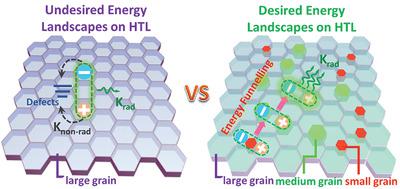当前位置:
X-MOL 学术
›
Laser Photonics Rev.
›
论文详情
Our official English website, www.x-mol.net, welcomes your
feedback! (Note: you will need to create a separate account there.)
Unraveling the Energy Landscape and Energy Funneling Modulated by Hole Transport Layer for Highly Efficient Perovskite LEDs
Laser & Photonics Reviews ( IF 9.8 ) Pub Date : 2021-02-01 , DOI: 10.1002/lpor.202000495 Ting Li 1 , Ting Xiang 1 , Miaosheng Wang 2 , Wei Zhang 3 , Jishan Shi 4 , Ming Shao 4 , Tianfei Xu 1 , Mahshid Ahmadi 2 , Xiaoyan Wu 5 , Zhao Gao 5 , Long Xu 1 , Ping Chen 1
Laser & Photonics Reviews ( IF 9.8 ) Pub Date : 2021-02-01 , DOI: 10.1002/lpor.202000495 Ting Li 1 , Ting Xiang 1 , Miaosheng Wang 2 , Wei Zhang 3 , Jishan Shi 4 , Ming Shao 4 , Tianfei Xu 1 , Mahshid Ahmadi 2 , Xiaoyan Wu 5 , Zhao Gao 5 , Long Xu 1 , Ping Chen 1
Affiliation

|
Previous reports have demonstrated significant effects of hole transport layer (HTL) on the morphology of quasi‐2 dimensional (2D) perovskites, hole injection, and interfacial defect density. However, the effects of HTL on energy landscape and energy funneling of quasi‐2D perovskites have not been revealed so far. Herein, the PEA2Csn−1PbnBr3n+1 perovskite films are fabricated on four types of HTLs including poly(9‐vinylcarbazole):poly(ethylene oxide) (PVK:PEO), PVK, poly(3,4‐ethylene dioxythiophene):poly(styrene sulfonate) (PEDOT:PSS), and nickel oxide (NiOx). The steady‐state and transient absorption spectroscopies reveal that the energy landscape and energy funneling of quasi‐2D perovskites vary significantly on different HTLs. All domains with n = 1, 2, 3, and higher order (n ≥ 4) are formed with desired population ratios on the PVK:PEO HTL, leading to the most efficient energy funneling. Furthermore, the interfacial passivation effect of PEO on the energy funneling process is studied. The light‐emitting diodes (LEDs) based on PEA2Csn−1PbnBr3n+1 and PVK:PEO (with an optimized ratio of 5.3:0.7 w/w) HTL result in a maximum luminescence of ≈23 110 cd m–2 and maximum external quantum efficiency of ≈11.5%, respectively. This is the best performance reported so far using pure PEA2Csn−1PbnBr3n+1 without perovskite composition modifications. This study provides new insights into the HTL for the development of highly efficient quasi‐2D perovskite LEDs.
中文翻译:

揭示由空穴传输层调制的高效钙钛矿LED的能量格局和能量漏斗。
先前的报告已经证明了空穴传输层(HTL)对准2维(2D)钙钛矿的形态,空穴注入和界面缺陷密度的显着影响。但是,到目前为止,还没有发现HTL对准2D钙钛矿的能量分布和能量分布的影响。本文中,PEA 2 Cs n -1 Pb n Br 3 n +1钙钛矿薄膜是在包括聚(9-乙烯基咔唑):聚(环氧乙烷)(PVK:PEO),PVK,poly(3, 4-乙烯二氧噻吩):聚苯乙烯磺酸盐(PEDOT:PSS)和氧化镍(NiO x)。稳态和瞬态吸收光谱显示,准2D钙钛矿的能量分布和能量分布在不同的HTL上有显着差异。与所有域Ñ = 1,2,3,和更高阶(Ñ ≥4)与对PVK期望人口比例形成:PEO HTL,导致最有效的能量漏斗。此外,研究了PEO在能量漏斗过程中的界面钝化作用。基于PEA 2 Cs n -1 Pb n Br 3 n +1和PVK:PEO(优化比例为5.3:0.7 w / w)的HTL发光二极管(LED)导致最大发光度≈23110 cd m –2最大外部量子效率分别约为11.5%。这是迄今为止使用纯PEA 2 Cs n -1 Pb n Br 3 n +1而不钙钛矿成分改变的最佳性能。这项研究为开发高效准2D钙钛矿LED提供了有关HTL的新见解。
更新日期:2021-04-11
中文翻译:

揭示由空穴传输层调制的高效钙钛矿LED的能量格局和能量漏斗。
先前的报告已经证明了空穴传输层(HTL)对准2维(2D)钙钛矿的形态,空穴注入和界面缺陷密度的显着影响。但是,到目前为止,还没有发现HTL对准2D钙钛矿的能量分布和能量分布的影响。本文中,PEA 2 Cs n -1 Pb n Br 3 n +1钙钛矿薄膜是在包括聚(9-乙烯基咔唑):聚(环氧乙烷)(PVK:PEO),PVK,poly(3, 4-乙烯二氧噻吩):聚苯乙烯磺酸盐(PEDOT:PSS)和氧化镍(NiO x)。稳态和瞬态吸收光谱显示,准2D钙钛矿的能量分布和能量分布在不同的HTL上有显着差异。与所有域Ñ = 1,2,3,和更高阶(Ñ ≥4)与对PVK期望人口比例形成:PEO HTL,导致最有效的能量漏斗。此外,研究了PEO在能量漏斗过程中的界面钝化作用。基于PEA 2 Cs n -1 Pb n Br 3 n +1和PVK:PEO(优化比例为5.3:0.7 w / w)的HTL发光二极管(LED)导致最大发光度≈23110 cd m –2最大外部量子效率分别约为11.5%。这是迄今为止使用纯PEA 2 Cs n -1 Pb n Br 3 n +1而不钙钛矿成分改变的最佳性能。这项研究为开发高效准2D钙钛矿LED提供了有关HTL的新见解。











































 京公网安备 11010802027423号
京公网安备 11010802027423号